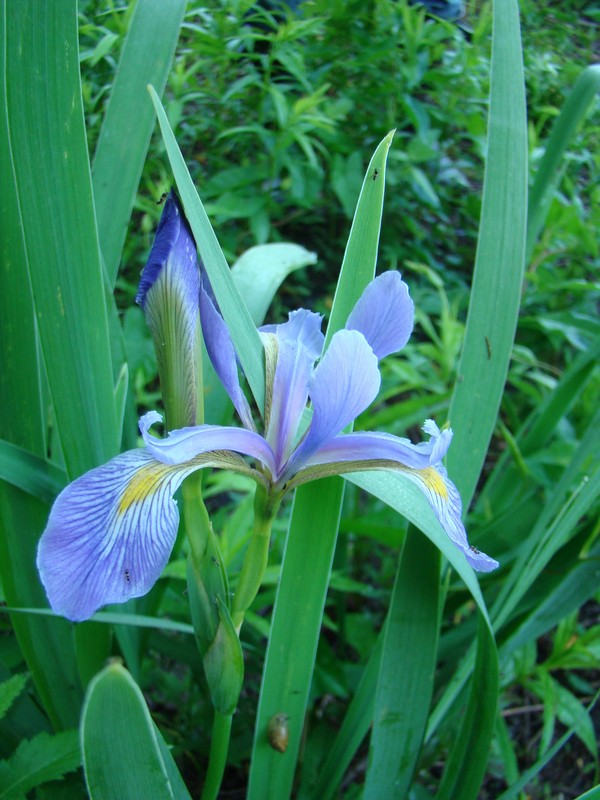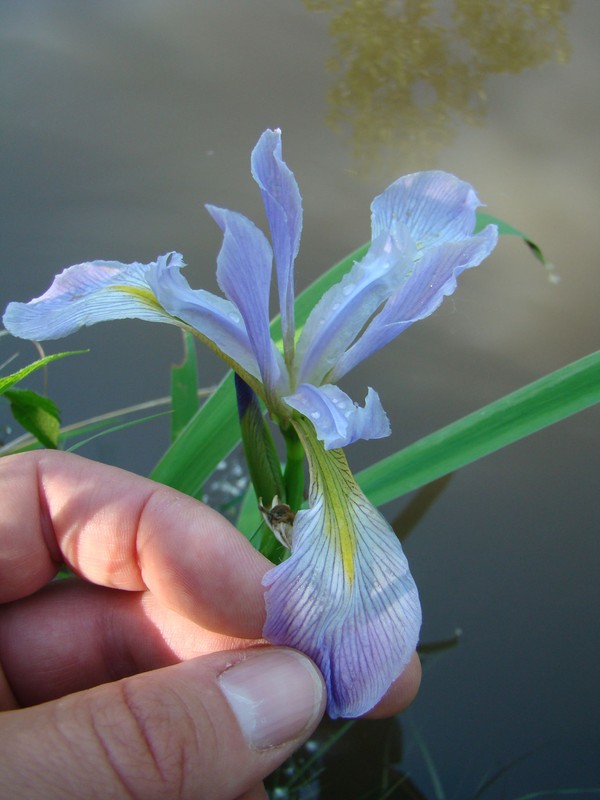Southern Blue Flag
Iris virginica L.
- Class
- Monocotyledoneae (Monocots)
- Family
- Iridaceae (Iris Family)
- State Protection
- Endangered
Listed as Endangered by New York State: in imminent danger of extirpation in New York. For animals, taking, importation, transportation, or possession is prohibited, except under license or permit. For plants, removal or damage without the consent of the landowner is prohibited.
- Federal Protection
- Not Listed
- State Conservation Status Rank
- S1
Critically Imperiled in New York - Especially vulnerable to disappearing from New York due to extreme rarity or other factors; typically 5 or fewer populations or locations in New York, very few individuals, very restricted range, very few remaining acres (or miles of stream), and/or very steep declines.
- Global Conservation Status Rank
- G5
Secure globally - Common in the world; widespread and abundant (but may be rare in some parts of its range).
Summary
Did you know?
This species was first discovered in New York in 1998.
State Ranking Justification
There are three existing populations along the Niagara River and one historical population near Sodus Bay.
Short-term Trends
The existing populations seem stable.
Long-term Trends
Most of the populations in New York were not found until after 1997.
Conservation and Management
Threats
Shoreline development, trampling by fishermen, boat traffic through the marshes, and invasive species threaten these populations.
Conservation Strategies and Management Practices
Invasive species should be suppressed near these populations. Fishermen and any planned trails should be kept away from the marshes where these occur.
Research Needs
There are no research needs identified at this time.
Habitat
Habitat
In New York, Southern Blue Flag has been found in open marshes and sedge meadows with saturated soils , typically dominated by cattails and graminoids (New York Natural Heritage Program 2013). Wetlands, margins of lakes and streams (FNA 2002). Swamps, marshes, meadows, and ditches (Gleason and Cronquist 1991). Marshes, bottomland, wet savannah, and shallow water (Fernald 1970)
Associated Ecological Communities
- Sedge meadow
(guide)
A wet meadow community that has organic soils (muck or fibrous peat). Soils are permanently saturated and seasonally flooded. The dominant herbs must be members of the sedge family, typically of the genus Carex.
- Shallow emergent marsh
(guide)
A marsh meadow community that occurs on soils that are permanently saturated and seasonally flooded. This marsh is better drained than a deep emergent marsh; water depths may range from 6 in to 3.3 ft (15 cm to 1 m) during flood stages, but the water level usually drops by mid to late summer and the soil is exposed during an average year.
Associated Species
- Acer negundo
- Agrostis stolonifera (creeping bent)
- Asclepias syriaca (common milkweed)
- Butomus umbellatus (flowering-rush)
- Carex granularis (limestone-meadow sedge)
- Carex lacustris (lake-bank sedge)
- Carex stricta (tussock sedge)
- Equisetum arvense (field horsetail, common horsetail)
- Eupatorium perfoliatum (boneset)
- Eutrochium maculatum var. maculatum (spotted Joe-Pye-weed)
- Glyceria melicaria (slender manna grass)
- Impatiens capensis (spotted jewelweed, spotted touch-me-not)
- Ipomoea hederacea (ivy-leaved morning-glory)
- Juncus tenuis (path rush)
- Lysimachia terrestris (swamp-candles)
- Lythrum salicaria (purple loosestrife)
- Nymphaea odorata
- Parthenocissus quinquefolia (Virginia-creeper)
- Phragmites australis (old world reed grass, old world phragmites)
- Physocarpus opulifolius (ninebark)
- Pontederia cordata (pickerelweed)
- Populus deltoides
- Rhus typhina (stag-horn sumac)
- Rubus odoratus (purple-flowering raspberry)
- Sagittaria latifolia (common arrowhead)
- Salix alba (white willow)
- Salix eriocephala (heart-leaved willow, Missouri willow)
- Sambucus nigra ssp. canadensis (common elderberry)
- Scirpus atrovirens (dark-green bulrush)
- Typha angustifolia (narrow-leaved cat-tail)
- Typha latifolia (wide-leaved cat-tail)
- Ulmus americana (American elm)
- Vitis riparia (river grape, frost grape)
Range
New York State Distribution
In New York Southern Blue Flag is found only on Niagara river islands, though there are historical records from the shore of Lake Ontario and from Long Island.
Global Distribution
New York marks the northeastern limit of this Iris's distribution. It ranges west to Minnesota, south to Louisiana and east Texas, and throughout most of the southeast.
Identification Comments
General Description
Iris virginica is an erect, colony-forming, perennial forb that grows from 50 cm to 1 m tall. It spreads via creeping rhizomes which typically bear 1 to 3 branches. The stems are solid and 2 to 3-branched. The leaves are basal, upright or suberect with buff to purplish bases. They are sword-like (linear-ensiform), with gray-green to bright green blades with several prominent ribs. The main inflorescences are 2 to 3-flowered. The flowers are 6-parted, with the outer parts (sepals) spreading and arched, 4 to 8.4 cm long by 1.6 to 4 cm wide, and pale blue to purple (rarely white) with darker lines and a fine, pubscent bright yellow patch at the base. The inner parts (petals) are somewhat lanceolate to spade-shaped, 3 to 7 cm long by 1 to 3 cm wide with often notched tips.. The fruits are prominently beaked capsules 5 to 10 cm long and 1.4 to 2 cm wide (FNA 2002).
Identifying Characteristics
Iris virginica is an erect, colony-forming, perennial forb that grows from 50 cm to 1 m tall. It spreads via its creeping rhizomes which bear typically 1 to 3 branches. The stems are solid and 2 to 3 branched. The leaves are basal, upright or suberect and generally sword-like (linear-ensiform) with gray-green to bright green blades with several prominent ribs on mature leaves and buff to purplish bases. The main inflorescences are 2 to 3 flowered, with 1 to 2 flowered branches. The flowers are 6-parted and enclosed by compact sheathing bracts (spathes) often bearing brown striations. They are typically lavender to violet colored, rarely white, with the outer parts (sepals) spreading and arched, 4 to 8.4 cm long by 1.6 to 4 cm wide, and pale blue to purple with darker blue or purple lines and a fine pubscent yellow patch at the base. The inner parts (petals) are somewhat lanceolate to spade-shaped, 3 to 7 cm long by 1 to 3 cm wide often notched tips and with a greenish yellow narrowed base (claw) bearing blue or purplish lines. The fruits are capsules are prominently beaked and frequently long-cylindic in shape and 5 to 10 cm long by 1.4 to 2 cm wide. (FNA 2002)
Best Life Stage for Proper Identification
For positive identification the whole plant including the stem, leaves and a mature intact flower is best.
Similar Species
A number of other Iris species occur in New York. Iris versicolor, the most similar to Iris virginiana, can be distinguished in flower by its pubescent green to greenish-yellow patch on the sepals that is surrounded by heavily veined, purple-on-white area (signal). Which contrasts with Iris virginica sepals which have a pubescent bright yellow patch at their bases. Iris prismatica also occurs on Long Island and the southern Hudson Valley but can be distinguished by its narrow leaves (2 to 9mm) and stoloniferous single stemmed habit, contrasting with Iris virginica rhizomatous, clumped growth habit and broader leaves (3 to 4 cm). Iris verna var. smalliana is a non-native species that can be distinguished from I. virginica by its broader leaves (5 to 13 cm), single-stemmed habit, and short stature, as it is only 5 to 15 cm tall.
Best Time to See
Southern blue flag typically flowers beginning in early May and continuing through mid-July. Fruiting typically begins in mid-June with fruits persisting until late September.
- Vegetative
- Flowering
- Fruiting
The time of year you would expect to find Southern Blue Flag vegetative, flowering, and fruiting in New York.
Southern Blue Flag Images
Taxonomy
Southern Blue Flag
Iris virginica L.
- Kingdom Plantae
- Phylum Anthophyta
- Class Monocotyledoneae
(Monocots)
- Order Liliales
- Family Iridaceae (Iris Family)
- Order Liliales
- Class Monocotyledoneae
(Monocots)
- Phylum Anthophyta
Synonyms
- Iris virginica var. shrevei (Small) E. Anders.
Additional Resources
References
Fernald, M.L. 1970. Gray's Manual of Botany. 8th edition. D. Van Nostrand, New York. 1632 pp.
Flora of North America Editorial Committee. 2002. Flora of North America, North of Mexico. Volume 26. Magnoliophyta: Liliidae: Liliales and Orchidales. Oxford University Press, New York. 723 pp.
Gleason, Henry A. and A. Cronquist. 1991. Manual of Vascular Plants of Northeastern United States and Adjacent Canada. The New York Botanical Garden, Bronx, New York. 910 pp.
Holmgren, Noel. 1998. The Illustrated Companion to Gleason and Cronquist's Manual. Illustrations of the Vascular Plants of Northeastern United States and Adjacent Canada. The New York Botanical Garden, Bronx, New York.
Mitchell, Richard S. and Gordon C. Tucker. 1997. Revised Checklist of New York State Plants. Contributions to a Flora of New York State. Checklist IV. Bulletin No. 490. New York State Museum. Albany, NY. 400 pp.
New York Natural Heritage Program. 2024. New York Natural Heritage Program Databases. Albany, NY.
Shreve, Ralph. 1927. Hardy Wildflowers from the Ozarks, Fall 1927-Spring 1928. Shreve Farm. Farmington, Arkansas.
Links
About This Guide
This guide was authored by: Richard M. Ring
Information for this guide was last updated on: December 8, 2022
Please cite this page as:
New York Natural Heritage Program. 2024.
Online Conservation Guide for
Iris virginica.
Available from: https://guides.nynhp.org/southern-blue-flag/.
Accessed July 26, 2024.


